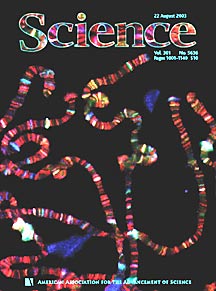'Sophisticated molecular machine' is found to govern cell's reading of genetic code in Cornell collaborative research
By Bill Steele

The process by which a cell reads the genetic code in its DNA in order to manufacture a protein is complex, involving dozens of enzymes and other biological molecules working together.
Now, research at Cornell University, using the fruit fly as a model system, has confirmed a theory about one step in the process by showing that a protein complex known as FACT is positioned in living cells at sites where chromosomal DNA is unpacked so that its code can be read. It is part of what the researchers call "a sophisticated molecular machine" that is not yet completely understood. The research is reported in the latest edition (Aug. 22) of the journal Science .
"This process is fundamental to the expression of all genes, whether they are normally expressed genes or genes that contribute to disease – all these use the same machinery," says John T. Lis, Cornell professor of molecular biology and genetics, who supervised the research.
Two other related papers on the topic also will be published in the same issue of Science from groups at the Robert Wood Johnson Medical School and Harvard Medical School. The cover image of the issue, from the Cornell and Robert Wood Johnson research groups, shows FACT appearing at the same locations as two other transcription factors on fruit fly (Drosophila ) chromosomes.
To fit into the nucleus of a cell, DNA must be packed into folded structures called nucleosomes that in turn form higher order structures. When the cell needs to manufacture a particular protein, nucleosomes open to expose the part of the chromosomal DNA where the gene for that protein is located. This allows an enzyme called RNA polymerase II to contact the gene to transcribe its code onto another molecule called messenger RNA. In turn, the messenger RNA travels out of the nucleus into the cytoplasm and to another cell structure called a ribosome, where a protein is manufactured according to the transcribed code.
But what causes the nucleosome to open? The theory has been that the FACT (short for Facilitates Chromatin Transcription) protein acts as a "chaperone" in the process. To confirm this, the Cornell researchers worked with a culture of fruit fly cells and studied the activation of a gene that responds to heat shock by rapidly making large amounts of protein that helps the fly adjust to heat stress. The process of gene expression is the same throughout the animal kingdom, so the work applies as much to humans as to fruit flies, Lis notes.
The researchers subjected the cell culture to a sudden rise in temperature to activate the gene. Within seconds the enzyme RNA polymerase II, familiarly known as Pol II (one of the three polymerase enzymes that work with different kinds of genes), travels to the multiple sites where the heat-shock genes reside and transcribes them. The researchers "froze" the process at various stages by introducing chemicals that, in effect, lock the various molecules involved into place, a process called cross-linking. They also introduced antibodies that attach to Pol II and FACT molecules and fluoresce in different colors under ultraviolet light.
With an optical microscope, the researchers could then see the location of Pol II and FACT on the DNA strand. By introducing the cross-linking at various times, they created a step-by-step record of the process. As predicted in the theory, they found that both Pol II and FACT quickly move to chromosomal sites containing the heat-shock gene.
Other proteins, Spt5 and Spt6, known as "elongation factors," also were found at the sites. When these were examined at still higher resolution by biochemical methods, the researchers found that FACT and Spt6 are located where they could be involved in the dissassembly of nucleosomes as well as their reassembly after transcription.
In related research reported in Science , Fred Winston of Harvard Medical School studied the same process in yeast, and Danny Reinberg of Robert Wood Johnson Medical School studied the biochemical mechanics of the process.
The Cornell paper is titled "Tracking FACT and the RNA Polymerase II Elongation Complex Through Chromatin in Vivo." Co-authors are graduate student Abbie Saunders, laboratory technician Janis Werner, postdoctoral fellow Erik Andrulis, collaborators Takahiro Nakayama and Susumu Hirose of the Japan National Institute of Genetics, who supplied critical antibodies for the experiments, and Reinberg.
Media Contact
Get Cornell news delivered right to your inbox.
Subscribe